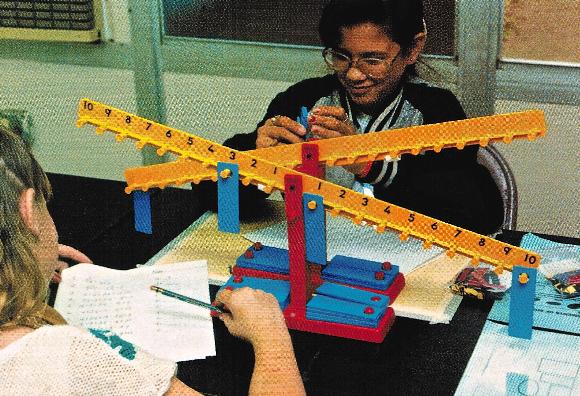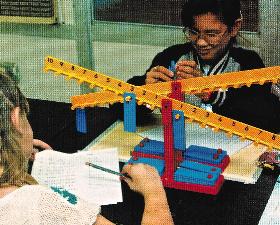
The amazing thing about Professor Shoecraft’s program is that once one sees the students doing their math, and liking it, the idea doesn’t seem remarkable at all—indeed, one is struck by its ordinariness. The essence of the program is to introduce each mathematical concept in at least three different ways through the use of manipulatives and to replace memorization [of all 390 number facts] with three skills: count up, count down, and skip-count. In many schools, manipulatives are used as supplementary materials and grafted onto the old curriculum; in Shoecraft’s schools, the manipulatives drive and make possible a new, more advanced curriculum.
In recent tests, POC kindergartners achieved at an average grade level of 3.0 on the Woodcock-Johnson test, with the lowest performer reaching the 2.1 grade level. “Special education” first graders achieved at grade level 2.1 on the same standardized test. These are unexpected results. POC is in a poor, rural community where the students have not been known for academic excellence or good high school graduation rates.
Still Shoecraft complains that these tests don’t reveal how much more the students have really learned. The use of tiles, coins, and balance beams, among other manipulatives, has given these children a strong sense of number, magnitude, place value, equality, area, and variable. More importantly, when these students do their additions, subtractions, multiplications, and divisions, they are not blindly performing operations, they are understanding what they are doing. Nicole knows that “eighteen divided by two equals nine” means that eighteen “things” can be put into “nine piles of two.” She
The assertion that “all kids can learn math” is probably the most radical idea associated with the education reform movement. It is likely that the majority of mathematics teachers don’t believe it.… Moms and Dads don’t believe it.… Kids don’t believe it.…
That all kids can learn math implies, of course, that all minorities, all women, all adults—indeed, anyone can learn mathematics. Furthermore, if anyone can learn mathematics, then ability grouping and tracking in school mathematics—arrangements meant to teach more to some, less to others—are obsolete and counterproductive.
Shoecraft’s MOVE IT Mathematics
Most of us are so inured to the idea that mathematics is necessarily a tedious, demanding chore that it is difficult to imagine a classroom in which all kids learn mathematics—or, even more remote, a classroom in which all kids enjoy their mathematics lessons. Yet, even this, and more, is possible. The idea that learning mathematics ought to be enjoyable is one of several principles in which University of Houston–Victoria Professor Paul Shoecraft grounds his MOVE IT (Math Opportunities, Valuable Experiences, Innovative Teaching) program. At the Port O’Connor (Texas) Elementary School, not only are all kids learning math, all of them are nuts about it.
Nicole, a first grader at POC and in her second year of the program, sat on the floor writing the answer to a problem she had just worked out. She gripped her pencil, fist like, her head well ahead of her motor skills.
“What are you doing, Nicole?” I asked.
“Adding fractions,” she said, glancing at me briefly but squarely in the eye. And, indeed, there in front of her was a set of problems involving the addition of fractions—some of which would make many a ninth or tenth grader tremble.
“Why, you’re too little to add fractions,” I teased. She looked at me hard and said, “Am not. I’ll show you.” And with that, she started to work on 2/3 + 1/6 = _____. Reaching in the box in front of her, she hunted up two pie-shaped wedges, one labeled 2/3 and the other 1/6. She fitted them carefully, then shuffled the pieces in the box around until she found two labeled 1/3, again fitting them carefully together. She puzzled a moment, then quickly traded in the two 1/3s for four 1/6s. She placed them together, then counted quickly, pointing to each separate wedge as she did, “One, two, three, four, five. Five-sixths! See?” She looked at me and grinned, picked up her pencil and scrawled a legible, albeit crude, 5/6 on her paper….
Anyone Can Learn Math: New Programs Show How
Robert Nielsen, mathematics professor and liaison between higher education and Al Shanker, President of the American Federation of Teachers, American Educator, American Federation of Teachers, Spring 1990
Next > | New Math Formula | Kindermath | Demonstration | Federal Funding | Inservice Funded | Anyone Can Learn Math | Summer Volunteers | Monster Math | Making Math Fun | Area Leaders | New Math of 90s | Video | MOVE IT! | Math Made Easy | VIPS to View Pgm | Gov. Richards | Richard's Attention | Revolution | Adds Up | Mexico | Letter | Atlanta 2003 | < Back — HOME

